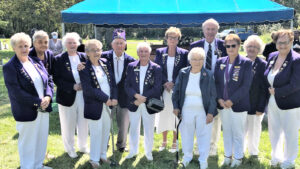The school year has not been smooth sailing for the custodial and administrative staff at Frank Maddock High School as there have been a number of incidents of vandalism.
Much of it appears to be linked to a social media challenge issued in September, called Devious Licks.
The challenge has been taken on by students across North America and has seen many arrests.
The vandalism has hit several schools in the Wild Rose School Division since the beginning of the year. “It was basic vandalism that was irritating, but it seemed manageable,” says WRSD Superintendent Brad Volkman.

Valley Gallery and Framing
Share on facebook Facebook Share on email Email Share on linkedin LinkedIn Share on whatsapp

St. Anthony Catholic Church
St. Anthony’s Parish Drayton Valley. Weekend mass Saturday and Sunday

Breton Dental Clinic
Share on facebook Facebook Share on email Email Share on linkedin LinkedIn Share on whatsapp

All Saints Anglican Church
Drayton Valley, All Saints Anglican Church participates in the Anglican Liturgy, which comforts and sustains us. Many have said that in such a busy and changing world it is important to come to a place that feels like home.

Valley Worship Assembly
Please take your time and discover what is happening at Valley Worship in Drayton Valley.
He says the challenge encouraged students to share their participation on social media.
The vandalism in the other schools has died down, but FMHS is still dealing with the issue. However, Volkman says it’s taken a different turn. “It went into a strange direction of trying to be as gross as you can,” he says.
Volkman says vandalism isn’t as much of a concern anymore. Rather, there are students who are defecating and urinating in places other than toilets and urinals. Some of the bodily fluids are then smeared all over the walls in the bathroom.
“The majority of the students who want to safely use the washroom are starting to feel nervous. They don’t know what they’re going to be walking into,” he says.
The school still isn’t sure who is causing the problem. Volkman says the school has also seen an increase of kids in the halls when they shouldn’t be, whether they are skipping class or just wandering around when on their spares, which makes it difficult to determine who’s responsible.
In an effort to prevent this, they have introduced a hall pass. Students can use an electronic hall pass, where they quickly scan a QR code and fill out a form which will get emailed to them. If they are uncomfortable using the QR code, there are physical hall passes they can take with them.
“The majority of the students who want to safely use the washroom are starting to feel nervous. They don’t know what they’re going to be walking into,”
Brad Volkman, Wild Rose School Division Superintendent
After principal Dr. Lara Jollymore announced the implementation of the new hall pass system the school and the division received backlash from students and parents.
The situation got so heated that someone started a petition on www.Change.org to have Jollymore fired. There were several hundred digital signatures on the petition, along with some comments that seemed to focus on Jollymore in a more personal manner.
Volkman says he’s been working closely with Jollymore in regards to the hall pass and increased supervision. He says he’s very supportive of her actions, as is the Parent Council.
“Instituting a hall pass is actually not new to schools in Alberta. There are many schools who are currently using them,” says Volkman.
Volkman says he believes that part of the issue was that they are using QR codes. He wants parents to understand that the school is not collecting any information on students. They are only having students partake in a digital hall pass.
“I think that some people think we’re tracking students to some degree, but that’s not the case. [The electronic pass] is the exact same as a paper hall pass, except it’s on the student’s phone,” he says.
He says all that the code does is record when the student leaves class and when they get back to class. “We’re trying to keep our bathrooms and hallways safe during a time when things seem to be a little bit off,” he says.
The Town of Drayton Valley is looking to the future as the municipality works toward having the utilities in the community be self-sustaining services.
Elvera Thomson, the general manager of corporate services for the Town, says in the past, the surpluses from the Town’s utility operations could be anywhere from $2-3 million. Those surpluses didn’t necessarily go into a fund specifically for water and sewer, but there was lots of money being put into reserves in general.
However, there wasn’t a policy that dictated that a certain amount of funds from the water and sewer revenues had to be put in reserves.
“What ended up happening as the years went on and things got tough, we had a series of events that happened with Covid, cost of living, inflation, and more,” says Thomson. “To manage tax increases, we just put less and less into reserves.”
Now, with the looming bill of repairing and replacing integral infrastructure in the community, the Town is putting a policy in place that will ensure the surplus from the utility services will be put into a reserve fund specifically for infrastructure maintenance and replacement.
“We just got to a point where none [of the surpluses] was going into reserves and we need to get back putting a large portion of those going into an internally restricted reserve for water and sewer,” says Thomson.
Those funds will go toward replacing the aging systems for water and sewer in the community. That way, the Town will not have to rely so heavily on debt funding or government grants for the projects.
While the Town was advised by Matt Delormes with the Atlantic Infrastructure Management Network that they need to put away as much as they can to help offset future costs. He told them that the ideal number would be $8 million, but understood that it wasn’t always possible to reach that number.
Thomson says they will not be able to put that amount of money away, but they are now taking conscious steps toward building their reserves.
She says there are many small towns across the country that are in similar situations, as aging infrastructure hasn’t been at the forefront of anyone’s minds until problems are starting to occur.
“It’s not just a municipal problem,” says Thomson. “It’s a provincial and federal problem as well.”
Thomson says that after World War II, there was an infrastructure boom across Canada, and many smaller communities were able to expand. This means that most of that infrastructure is coming due around the same time, and the municipalities are going to be looking toward the provincial and federal government to help with the costs of replacement.
Jordan’s Principle Grant funding delays are disrupting education in an Alberta schools
As of December 20, Wild Rose School Division will be laying off 46 Educational Assistants due to the division not receiving the Jordan’s Principle grant from the Federal Government.
Grant delay impact education assistant funding
Brad Volkman, the superintendent for WRSD, says in the past the funding has come through quickly and without any issues. The grant money is to be used to provide support and services to indigenous youth in the school division.
“Historically, these grants have been approved at the regional level, enabling us to offer critical services without interruption. Based on this expectation, we hired several additional Educational Assistants for the start of the 2024–2025 school year for the purpose of providing support to eligible First Nations students,” says a press release from WRSD.
Human rights tribunal couldn’t meet time demands
However, the Federal Government is currently backlogged when it comes to the grant. A Human Rights Tribunal was held to look into the funding, as it is supposed to be issued quickly as some requests for funds are urgent. They have since ordered the government to take action.
On December 10, 2024, Indigenous Services Canada responded in a report that it was not possible for them to meet the demands of the Tribunal.
Because there is no answer as to when the funding might come through, WRSD had to make the decision for layoffs as they had not budgeted for the positions outside of the grant.
The policy within WRSD is that when layoffs occur, those who are on probationary status, which is 120 days, are the first to be let go. There were 35 part-time and full-time EAs let go because of this policy. However, not all of them worked with Jordan’s Principle students.
One non-probationary EA was laid off, and the remaining ten were voluntary lay-offs, says Volkman.
“What happens is the probationary ones, due to collective agreement requirements, are laid off first, but then we can offer more tenured EAs those positions,” says Volkman.
He says the voluntary lay-offs were EAs working with Jordan’s Principle students who were offered positions with students who have more complex needs. Volkman says they declined the positions and had to be laid off.
“It’s not easy for them because in some cases the job they were offered would have been less hours or [perhaps] they would have been in a location that required them to drive a further distance,” says Volkman.
There are still 95 full-time EAs in the inclusive education department.
Drayton Valley Ski Hill Closes After 60 Years | Challenges with Weather, Insurance, and Volunteers
After 60 years of operation in the community, the Drayton Valley ski hill has closed its doors.
Weather, Insurance and Volunteers an issue
Randy Beckett, the president of the Drayton Valley Brazeau Snow Club, says there were three main factors that went into the decision to shut down: weather, insurance, and lack of volunteers.
The ski hill was built by volunteers and has been running with volunteers since then. Funding was partially provided by grants, fundraising, and rental and usage fees for the hill. These funds went toward bills like insurance and electricity. They were also used for the maintenance of the ski hill and the equipment. None of the volunteers were paid for their time.
When Beckett stepped into the role of president about eight years ago, the club was in debt and the equipment was in need of repair. A government grant of $17,000 and a massive fundraiser in the community gave them enough money to fix things up.
To round out their services, Beckett says they began to offer tubing. The club recognized that not everyone wanted to ski or were able to ski. Tubing was available to everyone and was less hard on the body. Each of the tubes was sponsored by a company, with the funds going toward the maintenance of the hill.
However, the lack of snow over the past few seasons has meant less use of the ski hill, and therefore less funds coming in.
“Unfortunately, Mother Nature has not been kind to us,” says Beckett.
In 2023, much of the local area didn’t have snow for Christmas. Beckett says the ski hill didn’t even open in the 2023/24 season.
“In my seven or eight years, we only opened three years because of snow,” says Beckett.
Insurance companies stepping away from offering coverage to ski hills
Then there was the issue with insurance. After a court case in B.C. where a customer sued a ski resort, many insurance companies stepped away from offering insurance to ski hills. Beckett says there are now only three underwriters in the world who will consider insuring a ski hill.
“Eleven of us little hills got our insurance canceled [a couple of] years ago,” says Beckett.
Previously, the Rural Municipalities of Alberta covered the insurance of the ski hill. When the insurance was cancelled through RMA, they had to find a new underwriter. The bill for the season was $24,000.
“Our insurance was $24,000 last year and we didn’t open,” says Beckett.
Finding volunteers to work the ski hill has also been a challenge.
“Everybody has so many different directions to go now in their lives,” he says. “They have just about everything except for time.”
On average, it took ten volunteers to run the ski hill each day. Beckett and his wife had a list of about 80 volunteers they could call on. However, there were times when they called all of those people and none of them were available to fill a shift for someone who had to cancel.
All three of those factors were at play when Beckett received a call from the insurance company in preparation for this season. They needed Beckett to go through everything on the property again, as they felt much of the equipment and the chalet were undervalued.
Beckett explained to them that it didn’t matter what the replacement value was for the chalet or the lift. If they failed or burned down, Beckett says the club would have to close.
With that in mind, he had put in a lower value for the chalet and other items as they would never be using the insurance to replace them. That was the only way they would be able to afford to run the ski hill. The insurance company explained that if he didn’t cover it for at least 90 percent of the replacement value they would get nothing.
“I said take the insurance off of it, I’ll take the risk,” he says.
Then the insurance company started going into details about the rental equipment, and how all of the people renting the bindings and skis had to be trained by the manufacturers in how to use them.
“What the real issue is, when it comes to insurance companies, is they do not like volunteer organizations in any way,” says Beckett. “Every one of these 11 hills that got their insurance cancelled, I believe, were volunteer organizations.”
Beckett says they feel that the volunteer organizations are unstable, as the volunteers can change regularly and with little notice.
The rental items for the ski hill will be auctioned off by Team Auctions on their December 7 sale. The property will be sold in the new year.
The Free Press asks – “What are your fondest memories of the Drayton Valley Ski Hill?”
“This fills me with nostalgia and gratitude! I started skiing at this hill at just two years old, and it ignited my love for skiing. My parents nurtured my passion by enrolling me in a ski program, and I spent countless weekends racing and growing. Our hill may not have been the biggest, but it was a place we were able to be kids at while not playing hockey or ringette. My dad and papa selflessly served as ski patrols for years, and we reveled in every moment we spent there. My papa’s dedication to the hill was remarkable as he had welded so many pieces there making it the hill it was today, and I’m deeply thankful for the volunteers who helped shape it into the haven it became. All three of my boys learned to ski on this hill, and I’m forever grateful for the escape and liberation it brought us.” – Leslie Anne Fraizer
“I learned to ski on the hill, my kids learned to ski on the hill. We’ve had many get-togethers on the hill with family and friends. As a volunteer I got to see so many littles learn to ski/snowboard and then advance to be on their own then onto the T-bar. They all get excited when they get to go on the big hill. I’ve spent many hours volunteering there as I was on the board for 20+ years and even when my kids weren’t skiing I was there.It was a great hill for many to learn on, it was in our backyard. When we decided to make the tube part it brought more families out which was great to see. It truly will be missed as I wanted my grandkids to learn how to ski/board this year on it.” – Georgia Frost
“Ooh, so many memories of the ski hill. But I would say the best was learning to snowboard there and getting courage to do the jumps off the hills … It was always fun since it was me and my sister. We had a blast, racing down getting to the bottom and the wind burnt faces ‘cause of it.” – Tricia Cottreau
“I was on the tow rope when a porcupine decided to cross… apparently the rope had enough give to allow the people to push a big loop in it. We were able to continue up the hill and the porcupine was able to continue on its walk about” – Helen Maine
“I have so many memories there as a teen in the mid 1980s… from trying to perfect the “daffy”, “backscratchers” and the “kusak” amongst learning how to telemark. This little hill with amazing volunteers taught a ton of youth some amazing skills while maintaining a very safe and supportive environment. I am a ski patrol today because of this little hill and the “gnarly” atmosphere back in the 80s that let youth hone their skills for the mountains.” – Jon Setterlund
“Watching my son Max snowboard for the first time! And he struggled with the T-bar but never gave up!” – Kathy Schwengler
“The time I knocked myself out cold. Couldn’t stop and hit a pole. That was my last time on skis. I now snowboard. I don’t think there’s any photos of that adventure…got a free sled ride behind the skidoo!!” – Jane Marie Ellis
“When Devon broke his arm, all the other kids that broke something and the fact that we all thought we had fresh pow days” – Gord Graham
“Donna and Val Palmer encouraged me to get my Level 1 ski instructor certification and teach ski lessons at the hill. I have so many memories of teaching kids and adults basic skills for skiing. My favourite memories include the Grade 5 visits and instructing a whole class on the tow rope hill. What a great introduction for those kids- who may have never been exposed to skiing.” – Astrid Mitchell
Drayton Valley Food Bank relies on generosity
With an increase in demand for the Drayton Valley Food Bank, volunteers are concerned the facility may not keep up for much longer.
Heather and Phil Bell, the vice president and treasurer respectively, have been with the Food Bank for several years. During that time they’ve noticed a concerning trend in the uptick of users.
So far this year, they have given out hampers to 2,275 people, a stark contrast to the 2023 number of 1,653. Last year was a record year for hampers and this year has blown it out of the water.
Alberta food bank sees increased demand
The Bells says a lot of the hampers are going to families who have parents that work.
“The Food Bank, I feel, is an essential service right now, considering the need,” says Phil. “It’s something that’s heavily relied on.”
If things continue the way they have been, they’re expecting to hand out 2,556 hampers by the end of the year.
“It’s not just a blip, either,” says Phil. “This is going to continue on.”
Phil says that though they’ve seen increased usage, the generosity of the community has continued to keep up with the demand. Between food donations from local stores and food drives, the food bank has already received around $270,000 of in-kind donations.
“We have such a generous community,” says Heather. “It’s amazing.”
Heather says they are grateful for the building they’re in and the Town’s generosity in letting them use it for free. She says the location is perfect because it allows people more privacy than a location in a busier part of the community.
“But we’re outgrowing the building,” says Heather. “We’re at the point with our freezer and fridge capacity that the building can’t take anymore fridges and freezers without upgrading the electrical system.”
Space is a challenge for Drayton Valley food bank
Fridge and freezer space are vital in the Christmas season. Heather says in the past, they’ve had to turn away donations of a side of beef because they don’t have the space. Some companies have set up freezers in their buildings and offered the extra storage. Some volunteers also store some items as well.
The Bells say a sea can or some other place where they could store dried goods would be extremely helpful, as well. As it is, they have to store enough food in their building for roughly 30 hampers each pick up day.
At the beginning of November, the volunteers changed their system, and now only offer hampers on Thursdays. Phil says one recent hamper day saw volunteers hand out 86 hampers in three hours.
Creating that many food hampers also has its challenges. There isn’t a lot of room to put the hampers together and organize them, though Heather says they’ve developed a good system. Volunteers are now prebuilding hampers with dried goods for different sizes of families. On pick up days, all they have to do is go to the fridge and freezer to top the hamper off, and it can go out the door.
Thanks to a grant from the Family and Community Support Services, the Food Bank now has a part-time employee that can help with a lot of the administrative tasks. However, some recent Standards of Excellence put forth by the Federal Government is putting pressure on them as well.
The Standards of Excellence requires all Food Banks to have certain policies and procedures in place if they want to continue to be registered with Food Banks Alberta and Food Banks Canada.
Heather says it’s a great idea in theory, but the 78 page document is a massive undertaking for a busy food bank run by volunteers. Their employee is working on some of the documents, but it’s still a challenge.
“A lot of them are great ideas, but for small food banks, it’s quite overwhelming to comply with that,” says Heather.
Originally, the food banks had until March 2025 to have everything in place, but after feedback, they’ve given the smaller food banks more time to work on it.
The Bells say there are many ways for the community to help out the food bank and they won’t turn down donations if they can help it. They have more volunteers who are going through the orientation and are grateful for the continuing generosity of the community.
Drayton Valley Launches Platform to Match Volunteers with Opportunities
Community members often perform their civic duties in a variety of ways; some vote, most pay their taxes, and some volunteer their time.
The initiative, This Is Drayton Valley (TIDV), is hoping to make it easier for residents to find ways they can volunteer in their community. They’ve launched an online platform, www.lets-volunteer.com, that helps connect organizations to residents who are looking for a place to volunteer their time.
Jessica Doucette, the chair of the Healthy Community Coalition, says the idea for the platform first began when the HCC were brainstorming ways to offer programs for the clients in the Youth Hub. The biggest obstacle was finding volunteers to help out with the programs.
“We came up with this idea about creating an online platform that would make it easier for people to access volunteer opportunities,” says Doucette.
She says at that time, they were mostly considering the Youth Hub and looking for younger volunteers. They felt that an online platform would be the best way to reach out to that demographic.
When Kickstand Alberta became the parent organization of the Youth Hub, they found more challenges. As they were a newer provincial body, they weren’t ready to take on the project for all of their Youth Hubs. Doucette says rather than scrap the idea, they decided to offer it to the larger community.
“We realized it was actually an issue for everybody,” she says.
Originally, they had approached the Chamber of Commerce, who had already tried to make a similar platform. But as the HCC works under the Red Cross, they were told it wasn’t appropriate for them to work with an organization that only represented businesses. They continued to look and finally connected with Ryan Fynn, one of the founders of TIDV, to bring the idea to life.
The platform has been active for a couple of weeks, now, and as of November 22, there were 14 volunteers and 12 organizations on the site.
Fynn says the platform is similar to dating websites, in that the volunteers input information into a profile and then they can be matched with an organization that would best suit them. He says volunteers are encouraged to list things they are passionate about, their relevant skills, experience as a volunteer, how much time they want to commit, and which days they are open to help. Organizations can search for volunteers based on those parameters.
“For an example, River Valley Players is looking for a part-time musical director,” says Fynn. “If a volunteer says they are passionate about music, they will be connected to them.”
Doucette says the platform can also help people connect with someone with specific skills. “We just recently did a survey through the community parenting coalition, and we found that there’s a large majority of people that are willing to share their gifts with others,” says Doucette. “We just don’t ask the right questions.”
Fynn says it would also work well for finding volunteers for events. By listing their events and indicating what’s all involved in the positions, residents with profiles can find them and help out.
Man charged after shooting near Brazeau Dam
An Edmonton man has been charged with attempted murder after an incident that took place near the Brazeau Dam last week.
Just before midnight on Saturday November 9, the Drayton Valley RCMP received a 911 call reporting possible shots fired near the dam. As members arrived, they received an update that a female had been shot by a man with a .22 calibre rifle. The suspect, who is believed to have been part of a group who had been hunting in the area, was arrested and taken into custody without incident. Officers administered first aid to the female victim, who was suffering from multiple gunshot wounds, until emergency medical services arrived on the scene. The female victim was transported to the University of Alberta hospital where she was listed in critical but stable condition.
Leomer Serios Valencia, 43, has been charged with attempted murder, using a firearm in the commission of an offence, pointing a firearm, assault and uttering threats. After a telephone bail hearing Valencia was remanded in custody pending an appearance in Drayton Valley court.
At this point, the school is handling the situation on their own. They have had conversations with the RCMP, but the police are not involved in an investigation.
Volkman says they want to find the students who are causing this situation so the vandalism can stop, but also so the students can get the mental help they need.
He says it has been predicted that the stress of Covid would lead to mental illness problems for many people. In an effort to stay ahead of the situation, WRSD hired additional wellness workers to help, basically doubling the amount they normally have in place.
“We knew the number of issues around mental health and wellness were going to be quite a bit higher,” he says.
The Town of Drayton Valley is looking to the future as the municipality works toward having the utilities in the community be self-sustaining services.
Elvera Thomson, the general manager of corporate services for the Town, says in the past, the surpluses from the Town’s utility operations could be anywhere from $2-3 million. Those surpluses didn’t necessarily go into a fund specifically for water and sewer, but there was lots of money being put into reserves in general.
However, there wasn’t a policy that dictated that a certain amount of funds from the water and sewer revenues had to be put in reserves.
“What ended up happening as the years went on and things got tough, we had a series of events that happened with Covid, cost of living, inflation, and more,” says Thomson. “To manage tax increases, we just put less and less into reserves.”
Now, with the looming bill of repairing and replacing integral infrastructure in the community, the Town is putting a policy in place that will ensure the surplus from the utility services will be put into a reserve fund specifically for infrastructure maintenance and replacement.
“We just got to a point where none [of the surpluses] was going into reserves and we need to get back putting a large portion of those going into an internally restricted reserve for water and sewer,” says Thomson.
Those funds will go toward replacing the aging systems for water and sewer in the community. That way, the Town will not have to rely so heavily on debt funding or government grants for the projects.
While the Town was advised by Matt Delormes with the Atlantic Infrastructure Management Network that they need to put away as much as they can to help offset future costs. He told them that the ideal number would be $8 million, but understood that it wasn’t always possible to reach that number.
Thomson says they will not be able to put that amount of money away, but they are now taking conscious steps toward building their reserves.
She says there are many small towns across the country that are in similar situations, as aging infrastructure hasn’t been at the forefront of anyone’s minds until problems are starting to occur.
“It’s not just a municipal problem,” says Thomson. “It’s a provincial and federal problem as well.”
Thomson says that after World War II, there was an infrastructure boom across Canada, and many smaller communities were able to expand. This means that most of that infrastructure is coming due around the same time, and the municipalities are going to be looking toward the provincial and federal government to help with the costs of replacement.
As of December 20, Wild Rose School Division will be laying off 46 Educational Assistants due to the division not receiving the Jordan’s Principle grant from the Federal Government.
Grant delay impact education assistant funding
Brad Volkman, the superintendent for WRSD, says in the past the funding has come through quickly and without any issues. The grant money is to be used to provide support and services to indigenous youth in the school division.
“Historically, these grants have been approved at the regional level, enabling us to offer critical services without interruption. Based on this expectation, we hired several additional Educational Assistants for the start of the 2024–2025 school year for the purpose of providing support to eligible First Nations students,” says a press release from WRSD.
Human rights tribunal couldn’t meet time demands
However, the Federal Government is currently backlogged when it comes to the grant. A Human Rights Tribunal was held to look into the funding, as it is supposed to be issued quickly as some requests for funds are urgent. They have since ordered the government to take action.
On December 10, 2024, Indigenous Services Canada responded in a report that it was not possible for them to meet the demands of the Tribunal.
Because there is no answer as to when the funding might come through, WRSD had to make the decision for layoffs as they had not budgeted for the positions outside of the grant.
The policy within WRSD is that when layoffs occur, those who are on probationary status, which is 120 days, are the first to be let go. There were 35 part-time and full-time EAs let go because of this policy. However, not all of them worked with Jordan’s Principle students.
One non-probationary EA was laid off, and the remaining ten were voluntary lay-offs, says Volkman.
“What happens is the probationary ones, due to collective agreement requirements, are laid off first, but then we can offer more tenured EAs those positions,” says Volkman.
He says the voluntary lay-offs were EAs working with Jordan’s Principle students who were offered positions with students who have more complex needs. Volkman says they declined the positions and had to be laid off.
“It’s not easy for them because in some cases the job they were offered would have been less hours or [perhaps] they would have been in a location that required them to drive a further distance,” says Volkman.
There are still 95 full-time EAs in the inclusive education department.
After 60 years of operation in the community, the Drayton Valley ski hill has closed its doors.
Weather, Insurance and Volunteers an issue
Randy Beckett, the president of the Drayton Valley Brazeau Snow Club, says there were three main factors that went into the decision to shut down: weather, insurance, and lack of volunteers.
The ski hill was built by volunteers and has been running with volunteers since then. Funding was partially provided by grants, fundraising, and rental and usage fees for the hill. These funds went toward bills like insurance and electricity. They were also used for the maintenance of the ski hill and the equipment. None of the volunteers were paid for their time.
When Beckett stepped into the role of president about eight years ago, the club was in debt and the equipment was in need of repair. A government grant of $17,000 and a massive fundraiser in the community gave them enough money to fix things up.
To round out their services, Beckett says they began to offer tubing. The club recognized that not everyone wanted to ski or were able to ski. Tubing was available to everyone and was less hard on the body. Each of the tubes was sponsored by a company, with the funds going toward the maintenance of the hill.
However, the lack of snow over the past few seasons has meant less use of the ski hill, and therefore less funds coming in.
“Unfortunately, Mother Nature has not been kind to us,” says Beckett.
In 2023, much of the local area didn’t have snow for Christmas. Beckett says the ski hill didn’t even open in the 2023/24 season.
“In my seven or eight years, we only opened three years because of snow,” says Beckett.
Insurance companies stepping away from offering coverage to ski hills
Then there was the issue with insurance. After a court case in B.C. where a customer sued a ski resort, many insurance companies stepped away from offering insurance to ski hills. Beckett says there are now only three underwriters in the world who will consider insuring a ski hill.
“Eleven of us little hills got our insurance canceled [a couple of] years ago,” says Beckett.
Previously, the Rural Municipalities of Alberta covered the insurance of the ski hill. When the insurance was cancelled through RMA, they had to find a new underwriter. The bill for the season was $24,000.
“Our insurance was $24,000 last year and we didn’t open,” says Beckett.
Finding volunteers to work the ski hill has also been a challenge.
“Everybody has so many different directions to go now in their lives,” he says. “They have just about everything except for time.”
On average, it took ten volunteers to run the ski hill each day. Beckett and his wife had a list of about 80 volunteers they could call on. However, there were times when they called all of those people and none of them were available to fill a shift for someone who had to cancel.
All three of those factors were at play when Beckett received a call from the insurance company in preparation for this season. They needed Beckett to go through everything on the property again, as they felt much of the equipment and the chalet were undervalued.
Beckett explained to them that it didn’t matter what the replacement value was for the chalet or the lift. If they failed or burned down, Beckett says the club would have to close.
With that in mind, he had put in a lower value for the chalet and other items as they would never be using the insurance to replace them. That was the only way they would be able to afford to run the ski hill. The insurance company explained that if he didn’t cover it for at least 90 percent of the replacement value they would get nothing.
“I said take the insurance off of it, I’ll take the risk,” he says.
Then the insurance company started going into details about the rental equipment, and how all of the people renting the bindings and skis had to be trained by the manufacturers in how to use them.
“What the real issue is, when it comes to insurance companies, is they do not like volunteer organizations in any way,” says Beckett. “Every one of these 11 hills that got their insurance cancelled, I believe, were volunteer organizations.”
Beckett says they feel that the volunteer organizations are unstable, as the volunteers can change regularly and with little notice.
The rental items for the ski hill will be auctioned off by Team Auctions on their December 7 sale. The property will be sold in the new year.
The Free Press asks – “What are your fondest memories of the Drayton Valley Ski Hill?”
“This fills me with nostalgia and gratitude! I started skiing at this hill at just two years old, and it ignited my love for skiing. My parents nurtured my passion by enrolling me in a ski program, and I spent countless weekends racing and growing. Our hill may not have been the biggest, but it was a place we were able to be kids at while not playing hockey or ringette. My dad and papa selflessly served as ski patrols for years, and we reveled in every moment we spent there. My papa’s dedication to the hill was remarkable as he had welded so many pieces there making it the hill it was today, and I’m deeply thankful for the volunteers who helped shape it into the haven it became. All three of my boys learned to ski on this hill, and I’m forever grateful for the escape and liberation it brought us.” – Leslie Anne Fraizer
“I learned to ski on the hill, my kids learned to ski on the hill. We’ve had many get-togethers on the hill with family and friends. As a volunteer I got to see so many littles learn to ski/snowboard and then advance to be on their own then onto the T-bar. They all get excited when they get to go on the big hill. I’ve spent many hours volunteering there as I was on the board for 20+ years and even when my kids weren’t skiing I was there.It was a great hill for many to learn on, it was in our backyard. When we decided to make the tube part it brought more families out which was great to see. It truly will be missed as I wanted my grandkids to learn how to ski/board this year on it.” – Georgia Frost
“Ooh, so many memories of the ski hill. But I would say the best was learning to snowboard there and getting courage to do the jumps off the hills … It was always fun since it was me and my sister. We had a blast, racing down getting to the bottom and the wind burnt faces ‘cause of it.” – Tricia Cottreau
“I was on the tow rope when a porcupine decided to cross… apparently the rope had enough give to allow the people to push a big loop in it. We were able to continue up the hill and the porcupine was able to continue on its walk about” – Helen Maine
“I have so many memories there as a teen in the mid 1980s… from trying to perfect the “daffy”, “backscratchers” and the “kusak” amongst learning how to telemark. This little hill with amazing volunteers taught a ton of youth some amazing skills while maintaining a very safe and supportive environment. I am a ski patrol today because of this little hill and the “gnarly” atmosphere back in the 80s that let youth hone their skills for the mountains.” – Jon Setterlund
“Watching my son Max snowboard for the first time! And he struggled with the T-bar but never gave up!” – Kathy Schwengler
“The time I knocked myself out cold. Couldn’t stop and hit a pole. That was my last time on skis. I now snowboard. I don’t think there’s any photos of that adventure…got a free sled ride behind the skidoo!!” – Jane Marie Ellis
“When Devon broke his arm, all the other kids that broke something and the fact that we all thought we had fresh pow days” – Gord Graham
“Donna and Val Palmer encouraged me to get my Level 1 ski instructor certification and teach ski lessons at the hill. I have so many memories of teaching kids and adults basic skills for skiing. My favourite memories include the Grade 5 visits and instructing a whole class on the tow rope hill. What a great introduction for those kids- who may have never been exposed to skiing.” – Astrid Mitchell
With an increase in demand for the Drayton Valley Food Bank, volunteers are concerned the facility may not keep up for much longer.
Heather and Phil Bell, the vice president and treasurer respectively, have been with the Food Bank for several years. During that time they’ve noticed a concerning trend in the uptick of users.
So far this year, they have given out hampers to 2,275 people, a stark contrast to the 2023 number of 1,653. Last year was a record year for hampers and this year has blown it out of the water.
Alberta food bank sees increased demand
The Bells says a lot of the hampers are going to families who have parents that work.
“The Food Bank, I feel, is an essential service right now, considering the need,” says Phil. “It’s something that’s heavily relied on.”
If things continue the way they have been, they’re expecting to hand out 2,556 hampers by the end of the year.
“It’s not just a blip, either,” says Phil. “This is going to continue on.”
Phil says that though they’ve seen increased usage, the generosity of the community has continued to keep up with the demand. Between food donations from local stores and food drives, the food bank has already received around $270,000 of in-kind donations.
“We have such a generous community,” says Heather. “It’s amazing.”
Heather says they are grateful for the building they’re in and the Town’s generosity in letting them use it for free. She says the location is perfect because it allows people more privacy than a location in a busier part of the community.
“But we’re outgrowing the building,” says Heather. “We’re at the point with our freezer and fridge capacity that the building can’t take anymore fridges and freezers without upgrading the electrical system.”
Space is a challenge for Drayton Valley food bank
Fridge and freezer space are vital in the Christmas season. Heather says in the past, they’ve had to turn away donations of a side of beef because they don’t have the space. Some companies have set up freezers in their buildings and offered the extra storage. Some volunteers also store some items as well.
The Bells say a sea can or some other place where they could store dried goods would be extremely helpful, as well. As it is, they have to store enough food in their building for roughly 30 hampers each pick up day.
At the beginning of November, the volunteers changed their system, and now only offer hampers on Thursdays. Phil says one recent hamper day saw volunteers hand out 86 hampers in three hours.
Creating that many food hampers also has its challenges. There isn’t a lot of room to put the hampers together and organize them, though Heather says they’ve developed a good system. Volunteers are now prebuilding hampers with dried goods for different sizes of families. On pick up days, all they have to do is go to the fridge and freezer to top the hamper off, and it can go out the door.
Thanks to a grant from the Family and Community Support Services, the Food Bank now has a part-time employee that can help with a lot of the administrative tasks. However, some recent Standards of Excellence put forth by the Federal Government is putting pressure on them as well.
The Standards of Excellence requires all Food Banks to have certain policies and procedures in place if they want to continue to be registered with Food Banks Alberta and Food Banks Canada.
Heather says it’s a great idea in theory, but the 78 page document is a massive undertaking for a busy food bank run by volunteers. Their employee is working on some of the documents, but it’s still a challenge.
“A lot of them are great ideas, but for small food banks, it’s quite overwhelming to comply with that,” says Heather.
Originally, the food banks had until March 2025 to have everything in place, but after feedback, they’ve given the smaller food banks more time to work on it.
The Bells say there are many ways for the community to help out the food bank and they won’t turn down donations if they can help it. They have more volunteers who are going through the orientation and are grateful for the continuing generosity of the community.
Community members often perform their civic duties in a variety of ways; some vote, most pay their taxes, and some volunteer their time.
The initiative, This Is Drayton Valley (TIDV), is hoping to make it easier for residents to find ways they can volunteer in their community. They’ve launched an online platform, www.lets-volunteer.com, that helps connect organizations to residents who are looking for a place to volunteer their time.
Jessica Doucette, the chair of the Healthy Community Coalition, says the idea for the platform first began when the HCC were brainstorming ways to offer programs for the clients in the Youth Hub. The biggest obstacle was finding volunteers to help out with the programs.
“We came up with this idea about creating an online platform that would make it easier for people to access volunteer opportunities,” says Doucette.
She says at that time, they were mostly considering the Youth Hub and looking for younger volunteers. They felt that an online platform would be the best way to reach out to that demographic.
When Kickstand Alberta became the parent organization of the Youth Hub, they found more challenges. As they were a newer provincial body, they weren’t ready to take on the project for all of their Youth Hubs. Doucette says rather than scrap the idea, they decided to offer it to the larger community.
“We realized it was actually an issue for everybody,” she says.
Originally, they had approached the Chamber of Commerce, who had already tried to make a similar platform. But as the HCC works under the Red Cross, they were told it wasn’t appropriate for them to work with an organization that only represented businesses. They continued to look and finally connected with Ryan Fynn, one of the founders of TIDV, to bring the idea to life.
The platform has been active for a couple of weeks, now, and as of November 22, there were 14 volunteers and 12 organizations on the site.
Fynn says the platform is similar to dating websites, in that the volunteers input information into a profile and then they can be matched with an organization that would best suit them. He says volunteers are encouraged to list things they are passionate about, their relevant skills, experience as a volunteer, how much time they want to commit, and which days they are open to help. Organizations can search for volunteers based on those parameters.
“For an example, River Valley Players is looking for a part-time musical director,” says Fynn. “If a volunteer says they are passionate about music, they will be connected to them.”
Doucette says the platform can also help people connect with someone with specific skills. “We just recently did a survey through the community parenting coalition, and we found that there’s a large majority of people that are willing to share their gifts with others,” says Doucette. “We just don’t ask the right questions.”
Fynn says it would also work well for finding volunteers for events. By listing their events and indicating what’s all involved in the positions, residents with profiles can find them and help out.
An Edmonton man has been charged with attempted murder after an incident that took place near the Brazeau Dam last week.
Just before midnight on Saturday November 9, the Drayton Valley RCMP received a 911 call reporting possible shots fired near the dam. As members arrived, they received an update that a female had been shot by a man with a .22 calibre rifle. The suspect, who is believed to have been part of a group who had been hunting in the area, was arrested and taken into custody without incident. Officers administered first aid to the female victim, who was suffering from multiple gunshot wounds, until emergency medical services arrived on the scene. The female victim was transported to the University of Alberta hospital where she was listed in critical but stable condition.
Leomer Serios Valencia, 43, has been charged with attempted murder, using a firearm in the commission of an offence, pointing a firearm, assault and uttering threats. After a telephone bail hearing Valencia was remanded in custody pending an appearance in Drayton Valley court.
Along with the hall pass, there will be increased supervision in the school. He says it has been difficult to determine who the culprits are, and the hope is that taking these additional measures will help to reduce the problem or at least help them find the students who are responsible.
“Then we can at least get these wellness resources to these kids, because this is not normal behaviour,” says Volkman.
For those who have concerns regarding Jollymore’s decisions, Volkman says he encourages them to talk to the principal directly. He says that will solve the majority of the issues. Those that aren’t resolved can then be escalated to the division office.

Support group for new Canadians
Verna Wicks, with Drayton Valley Community Learning (DVCL), is working together with other organizations in the community to build a Newcomers Support Team.

Bus association reaches end of the road
The Drayton Valley Community Bus Association, which has been a fixture in the area since the 1970s, has ceased operations.

Town responds to business concerns
Drayton Valley addresses homelessness, public safety, Town services, and free enterprise issues through detailed reports, communication strategies, and community solutions.

Drayton Valley builds reserves
Drayton Valley, Alberta, is planning for sustainable utilities by building reserves for future water and sewer infrastructure.
















